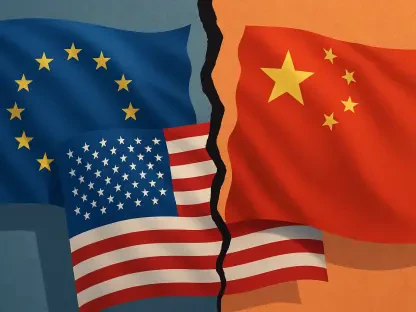Imagine a market of over a billion potential users, each representing a critical piece of the global tech puzzle, yet governed by some of the strictest digital regulations in the world. This is the reality Apple faces in China, where its latest innovation, Apple Intelligence, aims to redefine user experience through advanced AI capabilities. As one of Apple’s largest markets, China presents both an immense opportunity and a formidable challenge for rolling out this technology. This review delves into the intricacies of Apple Intelligence, examining its core features, adaptations for the Chinese landscape, and the complex interplay of regulation and innovation that shapes its deployment.
Core Features and Performance in the Global Context
Apple Intelligence stands as a cornerstone of Apple’s push into AI-driven consumer technology, offering features like enhanced voice assistance, predictive text, and personalized user interactions. Built into the latest iOS updates, this suite of tools leverages machine learning to anticipate user needs, streamline tasks, and integrate seamlessly across Apple devices. Globally, the technology has been praised for its intuitive design and robust privacy safeguards, setting a high bar for competitors in the consumer tech space.
In terms of performance, Apple Intelligence excels in environments where data privacy and user experience are paramount. Its on-device processing minimizes reliance on cloud storage, addressing concerns about data security that resonate with users worldwide. However, the true test of its capabilities emerges when adapting to unique markets with distinct cultural and regulatory demands, such as China, where customization becomes not just a feature but a necessity.
Adaptations for the Chinese Market
Compliance with Censorship and Content Management
To penetrate the Chinese market, Apple Intelligence has undergone significant modifications to adhere to stringent censorship laws. This involves filtering out sensitive content that might conflict with governmental guidelines, ensuring the AI avoids topics deemed inappropriate by local authorities. Such adaptations are not merely technical tweaks but involve complex algorithms designed to maintain functionality while respecting regulatory boundaries.
The ethical implications of these changes are substantial. Adjusting content to align with censorship requirements raises questions about the integrity of information delivery and the potential impact on user perception. While necessary for market entry, this balancing act between compliance and maintaining a trusted user experience remains a critical challenge for Apple’s strategy in this region.
Strategic Partnerships and Localized Integration
Apple has forged partnerships with local tech giants like Alibaba to tailor Apple Intelligence for Chinese consumers. Collaborations on AI models such as Qwen3 enable the technology to better understand and process local languages and dialects, enhancing its relevance to a diverse user base. These alliances also facilitate compliance with domestic tech standards, smoothing the path for regulatory approval.
Beyond language support, these integrations aim to embed cultural nuances into the AI’s functionality, making interactions more relatable for Chinese users. By leveraging local expertise, Apple seeks to create a version of its technology that feels native rather than foreign, a crucial factor in gaining acceptance in a market with strong domestic competitors. This approach underscores the importance of localization in achieving both technical and commercial success.
Regulatory Challenges and Market Entry Delays
Navigating China’s regulatory landscape has proven to be a significant hurdle for Apple Intelligence. Stringent rules on AI deployment and data privacy have delayed the technology’s rollout, with full implementation now expected in the coming year. These regulations demand rigorous scrutiny of AI systems, ensuring they align with national security and content control priorities, often at the expense of speed to market.
Geopolitical tensions further complicate the scenario, as approvals for tech deployments are sometimes tied to broader U.S.-China trade negotiations. Tariffs and diplomatic frictions add layers of uncertainty, impacting timelines and strategic planning. Apple’s efforts to maintain supply chain stability while addressing these external pressures highlight the high-stakes environment in which this technology is being introduced.
Additionally, domestic policies are evolving to create a clear divide between AI features available in open markets versus restricted ones like China. This bifurcation means that Chinese users may experience a version of Apple Intelligence that differs markedly from its global counterpart, potentially affecting user satisfaction and brand perception in the long run.
Market Applications and Competitive Positioning
Apple Intelligence is poised to drive device upgrades in China’s saturated smartphone market, where growth has slowed in recent years. By positioning AI as a key differentiator, Apple aims to entice users to adopt newer iPhone models equipped with these advanced features. The potential to revitalize sales through innovative technology is a critical aspect of Apple’s strategy in this competitive arena.
In comparison to local rivals like Huawei, whose AI offerings are already aligned with domestic preferences and regulatory expectations, Apple faces an uphill battle. Huawei’s deep integration into the Chinese tech ecosystem provides a benchmark for localized innovation that Apple must match or exceed. The ability of Apple Intelligence to adapt to user behavior and deliver value in everyday applications will be a deciding factor in its market traction.
Moreover, the technology’s impact on consumer behavior extends beyond hardware upgrades to influence how users interact with digital services. From personalized recommendations to smarter navigation tools, the practical applications of this AI could reshape daily routines, provided it overcomes initial barriers of trust and regulatory acceptance.
Challenges and Ethical Considerations
Among the most pressing challenges for Apple Intelligence in China are the delays caused by regulatory scrutiny and geopolitical dynamics. These obstacles not only hinder timely deployment but also create uncertainty around the final form of the technology offered to Chinese users. Balancing innovation with compliance remains a tightrope walk for Apple in this context.
Ethical concerns also loom large, particularly regarding the implications of censored AI features on user trust. When content is filtered to meet local standards, there is a risk that users may perceive the technology as less authentic or reliable compared to unfiltered alternatives available elsewhere. This perception could undermine Apple’s reputation among tech-savvy consumers who value transparency.
Furthermore, the broader tension between maintaining a global standard for AI innovation and making market-specific concessions poses a long-term risk. Apple must navigate these dual pressures with care, ensuring that its adaptations do not compromise the core values that define its brand while still securing a foothold in one of the world’s most lucrative markets.
Final Thoughts and Future Directions
Reflecting on the journey of Apple Intelligence in China, it becomes evident that the path is fraught with regulatory and ethical challenges that test Apple’s adaptability. The extensive modifications to comply with censorship laws, coupled with strategic partnerships, showcase a determined effort to penetrate a complex market. Despite delays and geopolitical headwinds, the technology’s potential to drive consumer engagement through innovative features remains a compelling prospect.
Looking ahead, actionable steps for Apple include deepening local collaborations to refine AI integrations and enhance cultural relevance. Engaging in proactive dialogue with regulators to expedite approvals could mitigate further delays, ensuring a smoother rollout. Additionally, prioritizing transparency about content management practices might bolster user trust, addressing ethical concerns head-on.
As the tech landscape continues to evolve, a key consideration is how Apple can influence global AI standards while navigating restricted markets. Exploring innovative ways to balance compliance with user expectations promises to shape not just Apple’s future in China, but also the broader discourse on technology deployment in regulated environments. The industry watches closely as these efforts unfold, anticipating lessons that could redefine market entry strategies for years to come.









